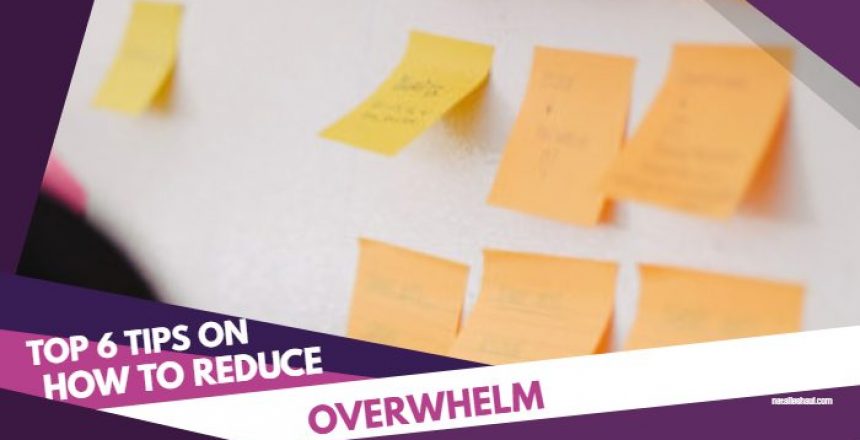What is Overwhelm?
It’s the feeling that you’ve got too much on your plate. You might find that your brain feels frozen at the thought of all you have to do. You might feel that if somebody asks you to do just one more thing… you are going to lose your mind and scream!
Brene Brown summed up nicely for me why we get to the point of overwhelm, she said women have this pressure to “Do it all. Do it now. And don’t even break a sweat.”
We feel a need to DO and BE everything, for everyone. In my experience, many women find it hard to say “NO”, we feel that doing so would be letting people down. It feels selfish and that doesn’t sit well. Perhaps we are also afraid of missing out! Saying NO feels uncomfortable for all these reasons and therefore we feel obliged to say YES!
What does overwhelm feel like physically and mentally?
I was physically and mentally drained. I was tired… but wired! My brain was constantly buzzing and humming with all that I needed to do, this meant I was unable to concentrate on any one thing. I would start a task but my mind would drift off elsewhere and I couldn’t focus on the task in hand. I wasn’t really getting anything done even though I felt I was always doing! I often felt resentful, as if people were ‘stealing’ my time and energy, I later realised that they weren’t stealing it, I was giving it to them!
Feeling overwhelmed switches on our bodies stress response also known as fight or flight. When our stress response is triggered, pretty much everything is too much! Even the smallest thing is the straw that breaks the camel’s back. You might also find that you are more jumpy, irritated and emotional.
It’s almost accepted as normal these days to feel overwhelmed. Isn’t everyone overwhelmed? But just because something is common doesn’t mean that it is normal! We don’t have to live in this way. Life is for living and enjoying and feeling overwhelmed isn’t exactly conducive to that!
Here are my top tips on how to reduce overwhelm –
I encourage you to recognise the signs that overwhelm is building. Catching it early and putting in place the below measures can prevent it from escalating.
- Breathe –
In a state of stress we tend to breathe in a short and shallow manner. By focussing on long and deep breaths we can switch off the stress response and move to a state of rest.
I find box breathing very effective. I like to lie back and put my hands to my lower belly, this allows me to feel my belly expanding which tells me that I am deep breathing into my stomach and not shallow breathing into my chest.
Next inhale for four slow counts, then hold that breath for four slow counts, exhale for four slow counts and then hold the out breath for four slow counts. That completes one box. Repeat this at least five times or until you feel calmer.
- Put pen to paper –
Get yourself a journal and use it to brain dump everything that it is on your mind – your thoughts and feelings and everything on your to do list. They are all taking up space in your brain which contributes to the feeling of overwhelm, remembering what needs to be done takes up energy which could be put to better use i.e. completing a task. Putting it down on paper is going to clear some space in your mind.
Writing a list can be helpful as it gives you a clear overview of all that needs to be done and allows you to prioritise based on the order of importance. I keep a running To Do list and then transfer items from that to a daily To Do list.
I find time chunking my tasks allows me to create achievable To Do lists. For example –
9-11am – Task 1
11.15am – Break
11.15 – 12.30 – Task 2
12.30 – 1pm – Lunch
- Have a routine –
Having a routine reduces the amount of time you need to spend figuring out what you are doing so that you have more time to do what you are doing! Routine can take the guesswork and uncertainty out of bits of our day, which can allow us to feel more in control and less stressed.
So make it part of your routine to sit down once a week to work out your To Do lists, or do it each night for the following day. Whichever works best for you.
Have a morning routine, an exercise routine, a meal routine. And don’t forget to make rest a part of your routine!
- Address your mindset –
Many of us have the belief that it is not okay to say NO but actually it is! And you don’t have to explain yourself or justify yourself or give a reason. NO is a complete sentence!
Saying NO when you are used to saying YES to everything can feel quite uncomfortable to start with. I encourage you to accept that it will feel uncomfortable the first few times that you say NO and to embrace it. It’s going to take some practice.
If you find that do want to say YES, you can set some realistic expectations. For example if a friend is moving house and you want to be able to help but actually but you don’t have all day, you could say “I can help you on Saturday between 12 and 3pm”. This way you are still saying YES but you are doing is setting their expectations and limiting it to the amount of time that you have available.
It’s also important to realise that you don’t have to do it all! You can insource the expertise for a particular task. A cleaner for example or a gardener. Or you can delegate to other members of your family.
- Ask yourself a question –
Let’s say an old work colleague from a long time ago that you aren’t that close to invites you to their wedding. If you had the time to attend you would like to but the bottom line is that it’s inconvenient. Ask yourself this question – “Am I saying yes because I want want to or because I feel like I should?”
If it’s the latter, could you find a compromise? For example could you send a gift but not actually attend? This way you’re not giving up your time for something that is not a priority in your busy life but you are still making an effort and them feel valued.
- Take time out –
I can’t stress how important it is to fill your own cup first! If you don’t you will eventually find that you have nothing left to give to anybody else. If you want to keep giving to other people on an ongoing basis, filling your own cup first is essential because then you will have plenty to flow over to the people that you love in your life.
Setting time aside for you to do nothing is key, it allows you to recuperate and rejuvenate. You’ll have more energy to keep giving and doing the things that you want and need to do in life.
Guilt free nothing time could be going for a walk, journaling, reading, listening to music or taking a soak in the bath. Putting this ‘nothing time’ on your To Do list makes it much more likely that you will set the time aside for it. If it’s not on the To Do list the chances are you will simply not get round to it!
I understand that having children, especially when they are young, brings a challenge to making time for yourself. But consider this… If you don’t, the example that you are setting to your children is that they should put themselves at the bottom of the pile. Is this the example you want to set? Do you want them to grow up and put themselves to the bottom of the pile? If not, then set the example that you and they are important and deserve some time out.
Remember life is for living and enjoying! If you don’t address overwhelm, over time it can lead to chronic and ongoing stress which affects both our physical and mental health.


